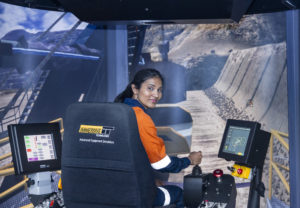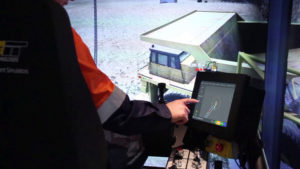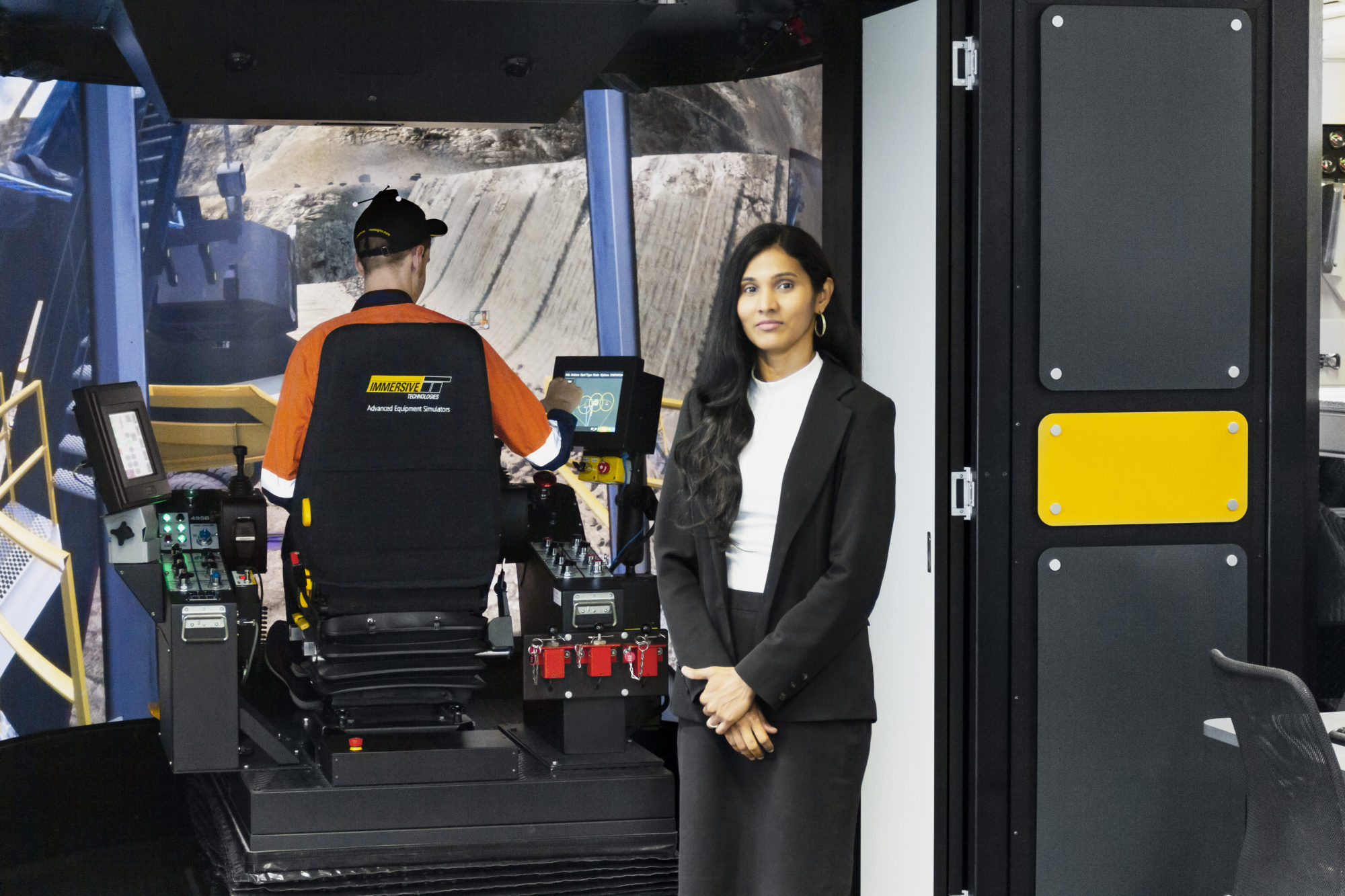New surface autonomous mining truck trials seem to pop up on an almost monthly basis, and not just new “autonomous” machines. Fleet retrofits of older models are cropping up, as are mixed AHS fleets (both in terms of truck brands and types but also mixed AHS and conventional truck fleets) and solutions from other players beyond just Caterpillar and Komatsu, including ASI/Epiroc, Hitachi and leading Chinese retrofit players like TAGE IDriver working with their Chinese mining truck OEM partners like XCMG and NHL. Plus the focus is no longer just on the Pilbara – from Imperial Oil and Suncor in the oil sands to Teck Resources coal and copper mines, copper in Chile and Peru, Australian and US gold operations, plus major investments in China – AHS is really beginning to take off as the benefits are proven again and again.
But little is ever said about how people are trained to work with these machines, and at the centre of it all is the loading machine operator who is loading the robotic trucks. IM spoke at length to Ravitha Sukumaran, Immersive Technologies’ Product Manager who specialises in training solutions for these operators. And in this autonomous mining training arena, Immersive is at the top of the pile in terms of experience & training systems.

“At first glance many assume there is an obvious reduction in training effort at autonomous versus manned sites. While it is true the volume of operator trainees is lower, the criticality of some roles has heightened the importance of advanced skills training. Mainly an increased importance is placed on the loading unit operator as well as operators of other ancillary manned machines. In an autonomous environment, these roles have more responsibility and mistakes or poor performance have the potential for a larger impact on the effectiveness of the operation. Due to these risks, we are seeing a more considered approach to workforce development where learning pathways from candidate screening right through to skills optimisation are being deployed in autonomous operations globally. In a conventional set-up, the digger operator’s standard responsibility is to dig and load as efficiently and safely as possible. But in an autonomous operation they not only have to operate the equipment effectively but also have to manage the entire loading area – by configuring spotting patterns, calling in trucks, kicking them out and managing the payload to ensure the autonomous trucks are not overloaded. With fewer eyes in the pit they are also more responsible for tasks that truck operators may have traditionally completed such as reporting spillage, sinking ground and handling unexpected or ambiguous situations which require elevated skill levels. They also maintain survey lines –the digital boundary delineating the safe working bench area which changes as digging progresses.”
So how can you possibly train an operator for such large task variety? “Accuracy of the simulated environment is very important, including ideal autonomous truck movements, and this is something we have refined over time with customer and OEM feedback. By emulating specific functionalities of the autonomous panel within the simulation environment of each specific machine, we’ve made the simulator training environment relevant for autonomous training with clear training objectives. We included additional training functionality including assistants in using the system to help increase learning retention and increase understanding of the impact of specific operator behaviours, including responses to emergency events which are not easily replicated in the field. This approach ensures that skills development from basic competency through to advanced skill optimisation can be achieved by the site.”

The requirements for higher proficiency and responsibility means the training takes longer than for manned operation training. Simulation has also proven to be an effective tool for screening aptitude and skills to increase the percentage of successful hires.
Training issues impacted mine goals early on in mining’s autonomous journey in the Pilbara but it is now pretty advanced compared to the rest of the world due to the collective experience of the region. Every other mine without exception located elsewhere that deployed autonomous trucks, or are planning to, sent teams to the Pilbara to try and learn from experienced personnel what the potential pitfalls are and how to address them. And all of these companies have also approached Immersive to understand the workforce development challenges and how they can efficiently prepare for the transition to autonomous mining. In many recent cases, mines have actually deployed Immersive autonomous simulators well before the autonomous fleet has arrived or started operating, as they want to have it in place well in advance to start training and increase readiness.
There is no difference in operator training for autonomous haulage systems when it relates to “new” autonomous trucks versus retrofitted machines as the trucks are simulated versions of the real equipment with additional autonomous components fitted to the external body of the machines such as mode lights, GPS antennas etc; and the Pilbara has both. Where there is a difference is between different mine types – the oil sands in particular could not be more different as a mining environment than the Pilbara, this has mainly been addressed by the OEMs rather than it being a training issue. As an example, it was quickly realised in the oil sands that trucks following the exact same paths with precision and accuracy repeatedly can be a problem due to the soft road conditions (especially in summer), the trucks taking the exact same paths every time could result in digging themselves into a deeper and deeper rut. By working with the OEMs, these mines addressed this challenge by creating multi-trajectory paths that allows the trucks to slightly alter their routes depending upon conditions.

Another difference is in the loading tools themselves. The Pilbara is dominated by large hydraulic excavators. In other big mines set to use autonomous fleets, especially in Latin America, large electric rope shovels are the norm. Immersive has adapted each machine’s simulation solution to allow for this which takes significant effort as it has to incorporate all the nuances of the different machines.
The market is also still evolving fast. Most of the Tier 1 miners have started autonomous fleet deployments or are set to – now it is the turn of the Tier 2 miners. Development is also underway on AHS solutions for smaller mining trucks and ADTs, plus some of the big mining contractors are getting into the mix in terms of taking taking on autonomous fleet responsibility. So, the training package for all these types of customers will be different. Immersive is still the only company to have any depth of experience in autonomous haulage system training; and of course it is now wholly owned by Komatsu, though Komatsu is only one of the options when it comes to autonomous haulage solutions. Immersive has continued to supply autonomous training simulator solutions for Caterpillar fleets even after the Komatsu takeover, for example.
But in the same way as Immersive supplies solutions for all the major OEM brands for conventional mines, this is not an issue for customers. “Our customers know our experience of working with all OEM machines. Our multi-OEM strategy is a strength as most mines have mixed fleets and miners want synthesis in their training solutions rather than a fragmented approach. When it comes to autonomous mining, the market knows Immersive Technologies is the ideal partner because of our experience and capability.”
The next big machine evolution is the coming of teleremote mining shovels which will be working with both manned and unmanned truck fleets. Things are still at a very early stage. Hitachi has announced its project will start in April 2021, while Komatsu, Caterpillar and Liebherr are known to be working on solutions and Komatsu Ltd mentioned a project on “remote controlled loaders” for mining in a recent set of results.
Sukumaran used the example of Immersive’s experience with training underground Caterpillar LHD teleremote operators at PT Freeport Indonesia’s Grasberg mine. “While this project was related to underground teleremote machines and was conducted over several years, it highlights some of the relevant issues & challenges to remotely operating surface shovels. This includes the lack of tactile and motion feedback to the operator such as feeling the machine and bucket response as the LHD rides up into the muckpile and reverses. As the operators were no longer in a cabin, they also had a tendency to exhibit more risky behaviour with the machine as they themselves are not at risk. This meant the LHDs were seeing more damage.”
As might be expected the experienced operators who transitioned from the in-cab LHD operation to teleremote found the lack of tactile feedback more difficult, and were initially less productive as a result, whereas new “green” operators had nothing to compare the simulator or teleremote experience with and found it less of an issue. The real OEM teleremote stations did not include a motion base as one of the aims was to avoid tiring the body during long shifts by having a static, comfortable chair. The simulator was able to recreate much of this.
Immersive developed an IM360 sim solution that helped the operators have a sense of the machine and mine wall extremities and the machine performance without any of the actual motion, all while making sure they achieved maximum productivity while maintaining the highest safety levels. The teleremote simulator replicated the real station with accuracy and included additional assistants and cues to provide immediate feedback to help increase learning retention and overall training efficiency.
Trainees were given 10 hours of classroom training, followed by 20 hours in an Immersive LHD R1600G IM360 simulator. As semi-autonomous operation was then introduced, operators trained for that by conducting a further 20 hours of training within an Immersive Technologies’ teleremote simulator.
Ultimately the teleremote project at Grasberg became a huge success and the company was able to train a lot of female staff that had previously been based in admin departments for operator positions. As they were so good at following procedures to the letter, they even achieved in some cases better results than experienced male operators.











